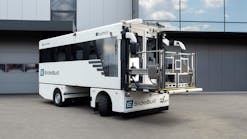Sea-Tac Explores Airport-owned GSE Model
In August 2009, the Seattle-Tacoma International Airport obtained $5 million in funding to purchase electric ground support equipment and charging stations. The award has been a boon to the airport’s goal of fully electrifying its GSE. To achieve the airport-wide approach, Sea-Tac has been exploring a new model for equipment ownership.
Funding for Electric
The airport obtained the funding for the vehicles through the Department of Energy’s American Recovery and Reinvestment Act of 2009. The airport worked with the Puget Sound Clean Cities Coalition to apply for the funding, which took about three months. A total of $15 million was awarded to the Clean Cities Coalition for four different projects, with the airport taking the largest share under the Transportation Sector Electrification portion of the grant.
The project to purchase electric equipment comes as part of the airport’s five-year plan to reduce emissions, under the strategic arm of this program designed to move people and goods more efficiently throughout the airport. (See Table 1)
The grant will subsidize the purchase of electric bag tugs, belt loaders and pushback tractors to replace its existing gas and diesel-powered equipment owned and operated by airlines. Based on tenant-airline estimates, the airport tenants have more than 650 ground vehicles that are looking to be replaced, according to Russ Simonson, senior environmental program manager at Port of Seattle.
The number of units the airport will be purchasing initially under the grant has yet to be determined, he says, adding that the business arrangements between the port and airlines for use of the equipment must be finalized before charging systems are installed and equipment is purchased.
Leasing Model
The final business arrangement could prove to be a unique model to airports in North America: one in which the airport might own the equipment and lease it for use on the ramp through an airline consortium.
“We are working with the airlines to try to figure out what the best way to fashion this deal would be, what’s the best business arrangement that makes sense financially for all of the parties,” says Elizabeth Leavitt, director of aviation planning and environment at Port of Seattle. “We haven’t really landed yet on how it’s exactly going to work, but certainly the thought that the port would buy the equipment and then lease it to a consortium of airlines who would then figure out among themselves how to work the equipment — that’s one of the things we’re strongly considering.”
Sea-Tac is considering the consortium business model for several reasons. “We have an opportunity to take advantage of lower interest financing than the airlines would, and we understand that sometimes you’ve got to incentivize programs where the equipment would be more expensive,” she says.
Stressing that no business arrangements have been made official and other strategies may still be a possibility at this point, Leavitt says the airport does see an advantage to the consortium concept. “One of the reasons why the consortium looks promising to us right now is that it allows us to install a number of locations at which equipment could be charged and have a more centralized approach,” she says.
The airport has also consulted with tenants to determine the best placement of the charging stations for operations, according to Leavitt.
As to the formation of the possible airline consortium, the finer details have yet to be considered, though the airport’s current fuel consortium could provide a model, she says.
Though in the early stages of strategy formation, the airport is working under a December 2011 deadline to finalize business arrangements and begin procuring equipment.
Sea-Tac foresees an incremental process of eventually implementing and replacing the entire GSE fleet at the airport with electric vehicles. “The current scenarios being studied are around an airport-wide approach,” Simonson says. “The installation of infrastructure would likely be phased in based on current electrical capacity and by concourses. Therefore, eGSE would be phased in as well as capacity comes online.”






